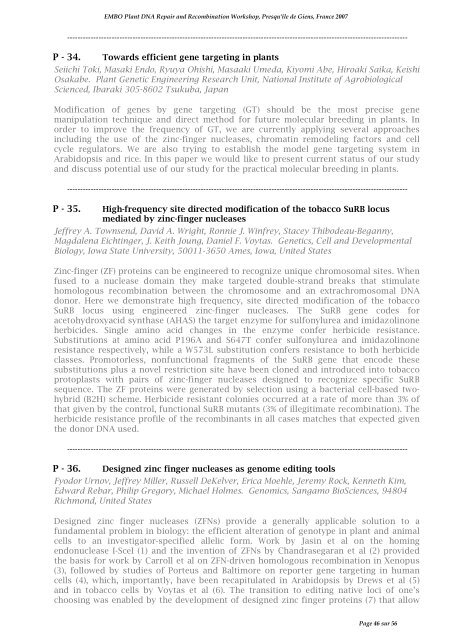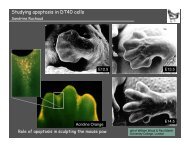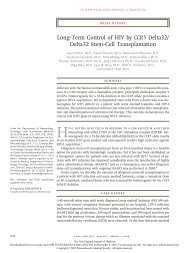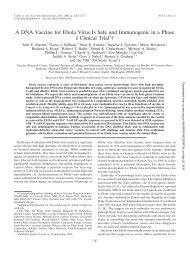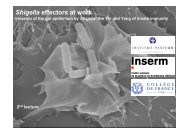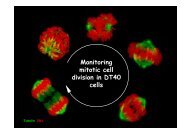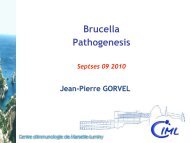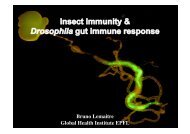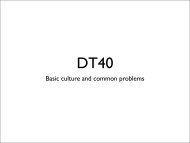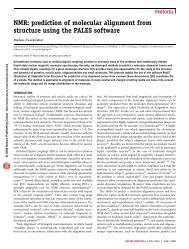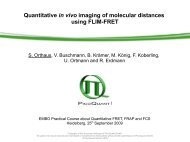pdf file - Events - EMBO
pdf file - Events - EMBO
pdf file - Events - EMBO
You also want an ePaper? Increase the reach of your titles
YUMPU automatically turns print PDFs into web optimized ePapers that Google loves.
<strong>EMBO</strong> Plant DNA Repair and Recombination Workshop, Presqu'île de Giens, France 2007<br />
----------------------------------------------------------------------------------------------------------------------------------<br />
P - 34. Towards efficient gene targeting in plants<br />
Seiichi Toki, Masaki Endo, Ryuya Ohishi, Masaaki Umeda, Kiyomi Abe, Hiroaki Saika, Keishi<br />
Osakabe. Plant Genetic Engineering Research Unit, National Institute of Agrobiological<br />
Scienced, Ibaraki 305-8602 Tsukuba, Japan<br />
Modification of genes by gene targeting (GT) should be the most precise gene<br />
manipulation technique and direct method for future molecular breeding in plants. In<br />
order to improve the frequency of GT, we are currently applying several approaches<br />
including the use of the zinc-finger nucleases, chromatin remodeling factors and cell<br />
cycle regulators. We are also trying to establish the model gene targeting system in<br />
Arabidopsis and rice. In this paper we would like to present current status of our study<br />
and discuss potential use of our study for the practical molecular breeding in plants.<br />
----------------------------------------------------------------------------------------------------------------------------------<br />
P - 35. High-frequency site directed modification of the tobacco SuRB locus<br />
mediated by zinc-finger nucleases<br />
Jeffrey A. Townsend, David A. Wright, Ronnie J. Winfrey, Stacey Thibodeau-Beganny,<br />
Magdalena Eichtinger, J. Keith Joung, Daniel F. Voytas. Genetics, Cell and Developmental<br />
Biology, Iowa State University, 50011-3650 Ames, Iowa, United States<br />
Zinc-finger (ZF) proteins can be engineered to recognize unique chromosomal sites. When<br />
fused to a nuclease domain they make targeted double-strand breaks that stimulate<br />
homologous recombination between the chromosome and an extrachromosomal DNA<br />
donor. Here we demonstrate high frequency, site directed modification of the tobacco<br />
SuRB locus using engineered zinc-finger nucleases. The SuRB gene codes for<br />
acetohydroxyacid synthase (AHAS) the target enzyme for sulfonylurea and imidazolinone<br />
herbicides. Single amino acid changes in the enzyme confer herbicide resistance.<br />
Substitutions at amino acid P196A and S647T confer sulfonylurea and imidazolinone<br />
resistance respectively, while a W573L substitution confers resistance to both herbicide<br />
classes. Promotorless, nonfunctional fragments of the SuRB gene that encode these<br />
substitutions plus a novel restriction site have been cloned and introduced into tobacco<br />
protoplasts with pairs of zinc-finger nucleases designed to recognize specific SuRB<br />
sequence. The ZF proteins were generated by selection using a bacterial cell-based twohybrid<br />
(B2H) scheme. Herbicide resistant colonies occurred at a rate of more than 3% of<br />
that given by the control, functional SuRB mutants (3% of illegitimate recombination). The<br />
herbicide resistance pro<strong>file</strong> of the recombinants in all cases matches that expected given<br />
the donor DNA used.<br />
----------------------------------------------------------------------------------------------------------------------------------<br />
P - 36. Designed zinc finger nucleases as genome editing tools<br />
Fyodor Urnov, Jeffrey Miller, Russell DeKelver, Erica Moehle, Jeremy Rock, Kenneth Kim,<br />
Edward Rebar, Philip Gregory, Michael Holmes. Genomics, Sangamo BioSciences, 94804<br />
Richmond, United States<br />
Designed zinc finger nucleases (ZFNs) provide a generally applicable solution to a<br />
fundamental problem in biology: the efficient alteration of genotype in plant and animal<br />
cells to an investigator-specified allelic form. Work by Jasin et al on the homing<br />
endonuclease I-SceI (1) and the invention of ZFNs by Chandrasegaran et al (2) provided<br />
the basis for work by Carroll et al on ZFN-driven homologous recombination in Xenopus<br />
(3), followed by studies of Porteus and Baltimore on reporter gene targeting in human<br />
cells (4), which, importantly, have been recapitulated in Arabidopsis by Drews et al (5)<br />
and in tobacco cells by Voytas et al (6). The transition to editing native loci of one’s<br />
choosing was enabled by the development of designed zinc finger proteins (7) that allow<br />
Page 46 sur 56


